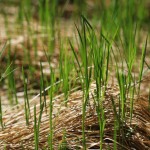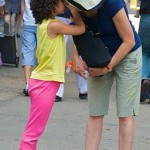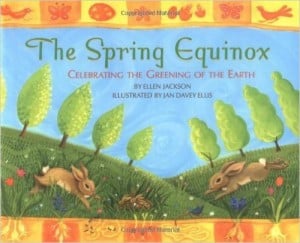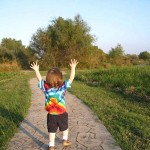by Meg Yardley
After my series reviewing picture books for celebrating the cycles of the sun and the seasons, I began to gather a list of favorite picture books honoring the moon. Let me just say: This is not an exhaustive list! Even after extensive searching, I’ve barely scratched the surface of all the picture books on this topic. So this is simply a list of some of my favorite Pagan-friendly moon books among those I’ve read – thirteen books for the thirteen full moons in a year. There is a bonus list below with some briefer reviews of additional books. Since I had so many wonderful choices, I didn’t include a few books (like “Goodnight Moon”) that are already familiar to most people. You are welcome to share your family’s favorite moon books in the comments below!
By the way, it turns out that many children’s picture books portray moon phases inaccurately (e.g. showing a waning crescent moon rising at sunset), so take note. You might want to study up on the science of moon phases so you can explain them correctly. You can teach your child to honor the moon by blowing a kiss to the moon each time they first see it in the sky, or singing a simple moon song when they see it (our family loves “Where is the Moon?” by Becky Reardon, from her album “Follow the Motion”; and there are a couple of lovely moon songs on “Circle Round and Sing” by Anne Hill). For some moon-related science activities to do with your children, try this list of five moon activities or this printable mini-booklet where your child can write words describing the different phases of the moon.
And now… my top thirteen moon picture books!
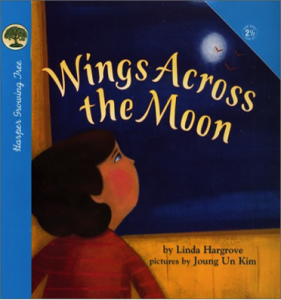 Wings Across the Moon, by Linda Hargrove, illustrated by Joung Un Kim
Wings Across the Moon, by Linda Hargrove, illustrated by Joung Un Kim
This rhyming book shows a child and parent watching all different types of animals and insects who are out as the moon rises: “First chance,/ Wings dance,/ Black against the moon./ Whose wings?/ Moth’s wings,/ Flutter, hum, and whir…” I love the contrasts in Joung Un Kim’s illustrations – between the soft moon and the sharp wings, or between the indoor space of the child’s room and the outdoor space where the owl flies. Great for older toddlers and up.
Pagan Notes: This beautiful book brings attention to the many forms of life that are active around twilight and into the night-time.
The House in the Night, by Susan Marie Swanson, illustrated by Beth Krommes
This Caldecott-Medal-winning bedtime story follows a child into their house (“Here is the key to the house./ In the house burns a light./ In that light rests a bed./ On that bed waits a book.”). The bird on the page of a book takes the child on a magical journey through the “starry dark”, seeing the moon and the sun. The journey winds back down through the book, the bed, the light, the house, the key. The text is really lovely and has a wonderful soothing bedtime rhythm; but what brings the story to life is the incredible scratchboard illustrations, which are all black and white except for the gold color of the moon, stars, lamp, etc. (as you see here on the cover). For babies (it’s available as a board book) and up.
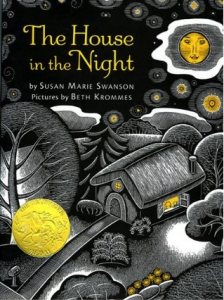 Pagan Notes: My very favorite part is: “Through the dark glows the moon./ On the moon’s face shines the sun./ Sun in the moon, moon in the dark…” In addition to the beautiful words, it’s refreshing when a children’s book is scientifically accurate in a way which highlights the magic of the natural world.
Pagan Notes: My very favorite part is: “Through the dark glows the moon./ On the moon’s face shines the sun./ Sun in the moon, moon in the dark…” In addition to the beautiful words, it’s refreshing when a children’s book is scientifically accurate in a way which highlights the magic of the natural world.
New Moon, by Pegi Deitz Shea, illustrated by Cathryn Falwell
An older brother teaches his toddler sister to look for “la luna” in the sky. This book features a lot of tender moments as he helps her through several nights of disappointment when there is no moon in the sky. Finally one day the brother comes home from school and wakes her up from her nap to show her the crescent new moon in the winter sky. I was a little confused about why the moon seemed to be dark right after a full moon – maybe it was hidden by the clouds during the waning nights? Anyway, this sweet book pleased both my toddler and older child, both of whom enjoyed repeating “no moon, no moon” after the toddler in the book.
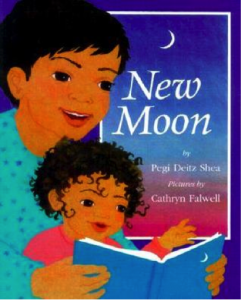 Pagan Notes: I loved how the brother teaches his little sister through observation and watching the sky; then, when the moon is not visible, he uses stories, songs, and drawings to teach her about the moon while they are waiting for it to reappear. It made me think about always returning to observation and experience when we are teaching children about nature.
Pagan Notes: I loved how the brother teaches his little sister through observation and watching the sky; then, when the moon is not visible, he uses stories, songs, and drawings to teach her about the moon while they are waiting for it to reappear. It made me think about always returning to observation and experience when we are teaching children about nature.
Max and the Tag-Along Moon, by Floyd Cooper
In this recent book by multiple-award-winning illustrator and author Floyd Cooper, young Max is sad about leaving his grandfather’s house, but grandpa reassures him that the moon “will always shine for you.” Max watches the moon on their drive home until it is hidden by storm clouds, causing Max to question his grandpa’s words. However, the moon reappears to illuminate his room as he falls asleep. This is a warm, gentle tale whose words and soft, glowing illustrations convey connection between a child and grandparent. Preschoolers and up. 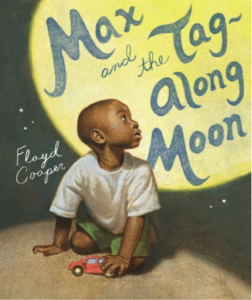
Pagan Notes: Young children first experience the divine through connection with parents and other special adults. If they feel loved, they are likely to develop a loving image of the divine (whether gods and goddesses, or an immanent Spirit that is present in all things). Though separation is hard for young children (and for adults), it is often helped by rituals that maintain the sense of relationship.
Red Knit Cap Girl, by Naoko Stoop
Red Knit Cap Girl lives in a forest with her animal friends; one of her wishes is to talk to the moon, so she tries to discover how to get the moon to come to her. She and her friends create a moon party with bright lanterns to attract the moon, but in the end she discovers that the moon will appear when she turns off the lights and creates darkness and quiet. The delicate illustrations are in a Japanese-animation-influenced style. For preschoolers and up.
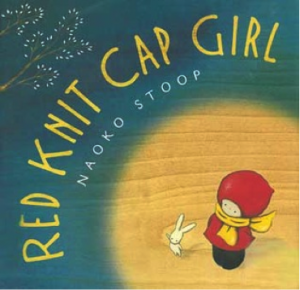 Pagan Notes: Although a moon party with festive lanterns is a lot of fun, I like the message that sometimes we need to turn off all the lights and return to a simpler, quieter way of relating to the moon. The author writes in a note that she was inspired to create this story after participating in Earth Hour, a national event where people agree to turn off their lights for an hour – this story kind of brings in that environmental message in a backdoor way.
Pagan Notes: Although a moon party with festive lanterns is a lot of fun, I like the message that sometimes we need to turn off all the lights and return to a simpler, quieter way of relating to the moon. The author writes in a note that she was inspired to create this story after participating in Earth Hour, a national event where people agree to turn off their lights for an hour – this story kind of brings in that environmental message in a backdoor way.
Mavis and her Marvelous Mooncakes, by Dar Hosta
Stripey orange cat Miss Mavis Sugar cooks up all kinds of sweet concoctions in her kitchen (there are several pages of examples) but the best is her mooncake! Each night for fourteen nights she makes a new slice to add to the pie, until one night the cake is done. “Mooncake, mooncake is so nice. Now, go ahead and eat a slice!” The text is mostly rhyming and has some repetitive elements which kids will appreciate, though it sometimes slips out of rhyme and then back in. Warning: the detailed descriptions of her sweet baking might lead to a feeling of sugar shock, and/or the whining of children who think they should actually get to eat these foods! For toddlers and up. 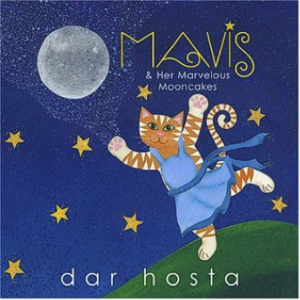
Pagan Notes: As with “The House in the Night” above, I really liked that the story contributes to an understanding of the phases of the moon, explaining how long it takes for the moon to grow (and at the end there is a page which shows the phases of the moon and gives some facts about the moon). Maybe it seems funny to give scientific props to a story of an orange cat who makes the moon out of cake… but we all understand the world through myth and story.
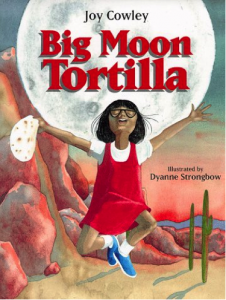 Big Moon Tortilla, by Joy Cowley, illustrated by Dyanne Strongbow
Big Moon Tortilla, by Joy Cowley, illustrated by Dyanne Strongbow
In this sweet story set in a Native American desert village in Arizona, young Marta Enos is working on her homework when she smells her grandmother’s “big moon tortillas” cooking. Her rush out to the cookhouse leads to her glasses getting broken and her homework being ruined… But her wise, compassionate grandmother shares a parable about how to put life in perspective. The author is not Native American but spent some time living in the village where this book is set. I loved the muted desert colors in the illustrations. For older preschoolers and up.
Pagan Notes: Though the book doesn’t talk about the moon in detail, the illustrations bring to life the visual analogy between the tortilla and the full moon. I liked the lesson about connecting with elements of nature (an eagle, a tree…) in order to experience time and perspective differently.
The Moon Was at a Fiesta, by Matthew Gollub, illustrated by Leovigildo Martinez 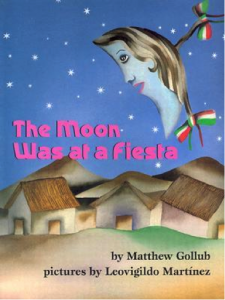
In this story set in Mexico, based on an Oaxacan saying, the moon is jealous of how much fun the sun is having and decides to throw a fiesta of her own. My child sums up: “But then the moon forgot to go behind the clouds when the sun came out and the people went off to bed.” This is why, when Oaxacans see the moon still in the sky in the morning, they might say “La luna se fue de fiesta!” This delightful story includes some entertaining illustrations by Oaxacan illustrator Leovigildo Martinez which bring the fiesta to life. For preschoolers and up.
Pagan Notes: I love this delightful exploration of the different realms of the sun and moon, the day and night, and the implication that both need to be valued equally. In the end, though, I felt the moon didn’t quite get the respect she deserved – this might be a good conversation point with your child.
If You Decide to Go to the Moon, by Faith McNulty, illustrated by Steven Kellogg
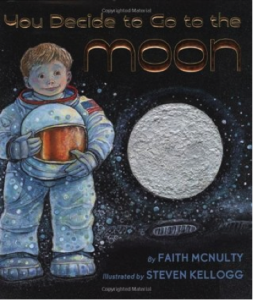 I wondered whether space travel would make for an exciting picture book, since I didn’t think the cover looked exciting. I was wrong to doubt! This book is beautifully written (poetic at times), funny, and imaginative; and the illustrations are more colorful and engaging than the cover suggests. The choice to tell the book in the second person makes the somewhat abstract idea of being an astronaut much more real, and the book portrays how you would eat, drink, and entertain yourself in space. There are plenty of facts about the moon, but not too many. The sequence in which the shuttle returns to earth is just beautiful, including a fold-out illustration of the world’s wide range of biomes, animals, plants, and people. And the book ends on a note about the urgency of protecting the planet’s air and water. For older preschoolers and up (the book is fairly long and has a good bit of text, but you can easily simplify for younger readers).
I wondered whether space travel would make for an exciting picture book, since I didn’t think the cover looked exciting. I was wrong to doubt! This book is beautifully written (poetic at times), funny, and imaginative; and the illustrations are more colorful and engaging than the cover suggests. The choice to tell the book in the second person makes the somewhat abstract idea of being an astronaut much more real, and the book portrays how you would eat, drink, and entertain yourself in space. There are plenty of facts about the moon, but not too many. The sequence in which the shuttle returns to earth is just beautiful, including a fold-out illustration of the world’s wide range of biomes, animals, plants, and people. And the book ends on a note about the urgency of protecting the planet’s air and water. For older preschoolers and up (the book is fairly long and has a good bit of text, but you can easily simplify for younger readers).
Pagan Notes: I don’t always think of space travel in the same breath as environmentalism, but I appreciated how this book married the two.
Tambourine Moon, by Joy Jones, illustrated by Terry Widener 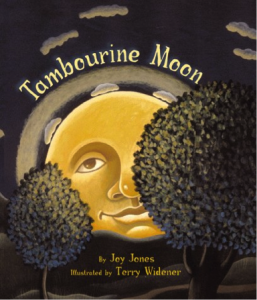
Young Noni is scared while walking through the city streets with her grandfather at night, so he tells her a story of when he was a young man in Alabama and met her grandmother. His story – told at an unhurried, Southern pace – ends with the grandmother’s tambourine jumping into the sky to light the way, “pouring light all over the night like butter running down the sides of a hot biscuit.” The book starts out a little choppy but gets a nice rhythm going, and the illustrations bring the story alive. A warm, slightly humorous story with a romantic side. For older preschoolers and up.
Pagan Notes: I love the tender, personal experience of nature in this book, from city streets to back country roads, and the fabulous commentary: “They say the moon works the night shift so that the sun can get some rest.”
Ladder to the Moon, by Maya Soetoro-Ng, illustrated by Yuyi Morales
Young Suhaila wishes she could have known her grandmother, about whom she hears only in her mother’s stories. One evening a ladder appears outside her window, and her grandmother leads her up the ladder to the moon, where they spend some time together. As they watch different things happening on earth, the moon becomes a gathering site for all those on earth who have died; their gathering and work together on the moon becomes a source of inspiration for those still on earth. Personally I found this book a little text-heavy and confusing at times (for example, it wasn’t clear to me at first whether the people were dying or magically escaping to the moon), but my child loved it. I love anything illustrated by Yuyi Morales; here, her billowing, nurturing human figures and luminous moonlit landscapes make the text more tangible and provide a sense of dreamy activism. For kindergarteners and up.
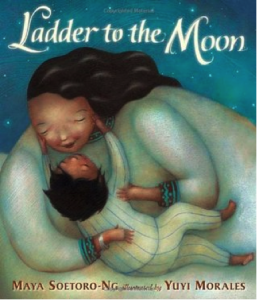 Pagan Notes: Although there’s nothing specifically Pagan about the idea of people living on the moon after they have passed away, the book ends with a beautiful vision of how those on earth can almost see the moon pulsing and humming with the energy of all those living there. In a sense, this book is about how we can draw energy and inspiration from those who have gone before us if we keep their memory and vision alive. The book specifically brings a multi-religious and multi-cultural vision of community and change. As a side note, Soetoro-Ng is also famous for being President Obama’s sister.
Pagan Notes: Although there’s nothing specifically Pagan about the idea of people living on the moon after they have passed away, the book ends with a beautiful vision of how those on earth can almost see the moon pulsing and humming with the energy of all those living there. In a sense, this book is about how we can draw energy and inspiration from those who have gone before us if we keep their memory and vision alive. The book specifically brings a multi-religious and multi-cultural vision of community and change. As a side note, Soetoro-Ng is also famous for being President Obama’s sister.
Thirteen Moons on Turtle’s Back, by Joseph Bruchac and Jonathan London, illustrated by Thomas Locker
Well-known Abenaki (Native American) author Joseph Bruchac brings together legends from a variety of different Native American tribes to match up with each of the thirteen full moons in a year. Some of them are more story-like, while others are poetic descriptions of the season. Beautiful book with soft, glowing illustrations. Kindergarten and up (younger kids may enjoy it but the text may be a little complex for them). 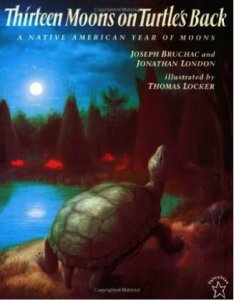
Pagan Notes: This book portrays the connection between spiritual practice and everyday life (gathering food, making dwellings…). A great way to introduce children to the diversity of different Native American tribes, as each moon’s story has a specific attribution.
“Where the Mountain Meets the Moon” by Grace Lin
For older readers, this gorgeously illustrated chapter book offers a feast of moon-related adventure in the form of Chinese legends. It is the story of young Minli, seeking the Old Man of the Moon to ask how to change her family’s fortune. Along the way, many stories are told, as she meets a dragon who cannot fly, a king disguised as a beggar, and a happy buffalo boy. In the end, of course, many mysteries are solved and Minli learns the true meaning of good fortune. Older preschoolers with longer attention spans will enjoy listening to this one – there are enough illustrations to provide a good visual accompaniment. I also love its companion book, “Starry River of the Sky,” the story of a young boy who comes to work at an inn. While hiding from the secrets in his past, young Rendi tries to solve a mystery: Why has the moon disappeared?
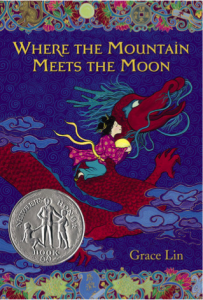 Pagan Notes: This is a wonderful introduction to Chinese legends (the story itself is original but many of the stories-within-a-story come from traditional folklore). The emphasis is on the importance of kindness, gratitude, and the value of family. Minli is also a brave and independent character, and I loved that the book does not give much attention to limitations placed on girls for their gender.
Pagan Notes: This is a wonderful introduction to Chinese legends (the story itself is original but many of the stories-within-a-story come from traditional folklore). The emphasis is on the importance of kindness, gratitude, and the value of family. Minli is also a brave and independent character, and I loved that the book does not give much attention to limitations placed on girls for their gender.
Brief Mention:
Grandfather Twilight, by Barbara Berger
In this peaceful book with brief, simple text, Grandfather Twilight selects a pearl from his chest and walks through the woods with the pearl trailing a luminous glow behind him, until he reaches the edge of the lake, where he gently throws the pearl up into the sky and it becomes… you guessed it, the moon.
Can’t Sleep, by Chris Raschka
Soothing, sweet story whose illustrations show a little puppy who can’t sleep. The rhyming text speaks of the moon watching over you at night while you sleep; then, when morning comes, you can watch over the moon while she takes her turn sleeping.
Thanking the Moon, by Grace Lin
Reviewed in Autumn Equinox books.
Possum’s Harvest Moon, by Anne Hunter
A possum organizes a party to celebrate the full harvest moon, but everyone is too busy harvesting to take part! Finally the moon works its magic and various critters show up in time to enjoy the moonlight and good company.
Moon Rope/ Un Lazo a la Luna, by Lois Ehlert, translated by Amy Prince
In this bilingual retelling of a Peruvian legend, a fox persuades mole to join him in climbing up a rope to the moon. The mole slips and falls, and is ridiculed by other animals – but what about the fox? Did he make it to the moon? Look up at the full moon and see for yourself… My child thought this one was funny and liked the part where the mole falls. For young preschoolers and up.
When the Moon is Full, by Penny Pollock, illustrated by Mary Azarian
Short rhyming poems describe the different moons of the year (Hunter’s Moon, Strawberry Moon, Green Corn Moon…). The illustrations are absolutely gorgeous; however, I felt mixed about the generically “Native American” inspired concepts. I would substitute Joseph Bruchac’s “Thirteen Moons on Turtle’s Back” (or use it to follow up for more depth).
The Moon Book, by Gail Gibbons
Facts about the moon’s features and phases, nicely illustrated in an accessible format. Briefly mentions legends about gods and goddesses of the moon (“a long time ago, people believed…”) and at the back there is an inset briefly describing different myths and legends.
Owl Moon, by Jane Yolen, illustrated by John Schoenherr
This Caldecott Medal book conveys the mood of the hushed winter woods through which a child and her father go “owling.” Full of excitement that she is finally old enough to go, the child braves the cold and silence and darkness of the woods, watching and waiting until her father’s call finally brings a great horned owl into sight. This story reminded me of “full moon walks” that some families do at night – a beautiful ritual to connect with the cycles of the moon. Yolen’s beautiful, poetic text brings alive a magical moment of wonder and togetherness for a father and child. For preschoolers and up.
The Moon Lady, by Amy Tan
This story, adapted from “The Joy Luck Club,” tells of a young girl celebrating the Mid-Autumn Moon Festival: interactions with her family, her wishes for the Moon Lady, and an adventure when she gets separated from her family. The brightly colored illustrations are gorgeous. The ending left a bad taste in my mouth, though, in its negative portrayal of a male actor playing the Moon Lady. Without the context of the original book, the narrator’s reaction conveyed the message that it is shameful and unattractive for a man to cross-dress – not the gender message I want to pass on.
The Moon Might be Milk, by Lisa Shulman, illustrated by Will Hillenbrand
Young Rosie and her cat wonder together what the moon is really made of. Cat thinks it’s milk, while other animals propose other ideas (a bowl of sugar… a pat of butter… a bag of flour). Rosie keeps an open mind until her wise grandmother puts together all the ingredients that have been named, making round moon-shaped sugar cookies. Sugar cookie recipe at the end.
Meg Yardley is a Pagan and a parent of two young children, living in the San Francisco Bay Area. She sings with the Turning Earth Singers, a Pagan music ensemble which recently led a “Pagan Kids’ Song and Story Time” workshop. She appreciates pictures books as a wonderful spiritual practice parents and young children can share.
Editor’s Note: You can find books reviewed at Pagan Families in our Amazon store.


